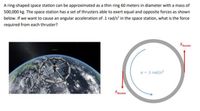
Elements Of Electromagnetics
7th Edition
ISBN: 9780190698614
Author: Sadiku, Matthew N. O.
Publisher: Oxford University Press
expand_more
expand_more
format_list_bulleted
Concept explainers
Question

Transcribed Image Text:A ring-shaped space station can be approximated as a thin ring 60 meters in diameter with a mass of
500,000 kg. The space station has a set of thrusters able to exert equal and opposite forces as shown
below. If we want to cause an angular acceleration of .1 rad/s² in the space station, what is the force
required from each thruster?
thruster
a =1 rad/s
Finruster
Expert Solution
This question has been solved!
Explore an expertly crafted, step-by-step solution for a thorough understanding of key concepts.
This is a popular solution
Trending nowThis is a popular solution!
Step by stepSolved in 2 steps with 2 images

Knowledge Booster
Learn more about
Need a deep-dive on the concept behind this application? Look no further. Learn more about this topic, mechanical-engineering and related others by exploring similar questions and additional content below.Similar questions
- A 5kg lacrosse stick has a moment of inertia about a transverse axis through its center of gravity of 8 kg.m2. When a player swings the stick at an opponent, the axis of rotation is through the end of stick, 80 cm from the center of gravity of the stick. What is the moment of inertia relative to this swing axis? A 4 kg lacrosse stick has a radius of gyration of 60cm about a transverse axis through its center of gravity. When a player swings the stick at an opponent, the axis of rotation is through the end of stick, 120cm from the center of gravity of the stick. What is the moment of inertia relative to this swing axis?arrow_forward(b) An electric motor lifts a mass of 500 kg from the ground to a height of 30 m in 1.5 minutes. Calculate the motor's output power during operation. The gravitational acceleration, g, is 9.81 m. s-².arrow_forward4) This Atwood's machine includes two blocks connected by a cable, going over a pulley without slipping. Block 1 (30.0 kg) is connected to a spring (70.0 N/m), and slides on a horizontal surface with a coefficient of kinetic friction of 0.0100. Block 2 is 50.0 kg, and hangs vertically from the cable. The pulley is a disk with a radius of 0.500 m, and its moment of inertia about the center of mass is 10. 0 kg-m“. a) Draw the three free body diagrams, and write out Newton's 2nd Law for each. b) Derive the equation of motion (inhomogeneous 2nd order ODE) for this system. c) Use u-substitution to rewrite this as a homogeneous 2nd order ODE. d) Assume the position x as a function of time t is of the form x(t) = A cos (wt + p) I disk for undamped natural frequency w, phase angle P, and amplitude A. The initial conditions are: x(0) v(0) = -3. 00 m/s. Solve for the position of the mass as a function of time (you need to solve for w, 4, and A). = 2. 00 m and Mzarrow_forward
- 550 g static mass Time to Complete 60 Revolutions 39 sec Radius of Rotation for the Rotating Mass . 144 m Mass of the Rotating Mass . 449 kg % Difference Between the Static ans Centripetal Forcesarrow_forward2. For the system below: a. Give an equation of motion for h. Note that the system has two inputs, p1 and p2. b. When h= 5, give the force exerted on the bottom of the tank. (Assume that the width and height of the opening at the bottom of the tank is negligible. The area of the bottom of the tank is A). h PA PI P2 PA Rarrow_forwardWhat is the relationship between in the input force and the velocity of mass three v3(s)/F(s)?arrow_forward
- *18-12. Determine the velocity of the 50-kg cylinder after it has descended a distance of 2 m. Initially, the system is at rest. The reel has a mass of 25 kg and a radius of gyration about its center of mass A of kд = 125 mm. 75 mmarrow_forwardA 2.0 kg object is moving to the right with a speed of 1.0 m/s when it experiences the force shown in the graph at right. What are the object’s speed and direction after the force ends? Paste the completed Bar Chart below. 1. identify the system 2. draw a quick sketch of the initial state of the object(s) 3. do a momentum bar chartarrow_forward
arrow_back_ios
arrow_forward_ios
Recommended textbooks for you
 Elements Of ElectromagneticsMechanical EngineeringISBN:9780190698614Author:Sadiku, Matthew N. O.Publisher:Oxford University Press
Elements Of ElectromagneticsMechanical EngineeringISBN:9780190698614Author:Sadiku, Matthew N. O.Publisher:Oxford University Press Mechanics of Materials (10th Edition)Mechanical EngineeringISBN:9780134319650Author:Russell C. HibbelerPublisher:PEARSON
Mechanics of Materials (10th Edition)Mechanical EngineeringISBN:9780134319650Author:Russell C. HibbelerPublisher:PEARSON Thermodynamics: An Engineering ApproachMechanical EngineeringISBN:9781259822674Author:Yunus A. Cengel Dr., Michael A. BolesPublisher:McGraw-Hill Education
Thermodynamics: An Engineering ApproachMechanical EngineeringISBN:9781259822674Author:Yunus A. Cengel Dr., Michael A. BolesPublisher:McGraw-Hill Education Control Systems EngineeringMechanical EngineeringISBN:9781118170519Author:Norman S. NisePublisher:WILEY
Control Systems EngineeringMechanical EngineeringISBN:9781118170519Author:Norman S. NisePublisher:WILEY Mechanics of Materials (MindTap Course List)Mechanical EngineeringISBN:9781337093347Author:Barry J. Goodno, James M. GerePublisher:Cengage Learning
Mechanics of Materials (MindTap Course List)Mechanical EngineeringISBN:9781337093347Author:Barry J. Goodno, James M. GerePublisher:Cengage Learning Engineering Mechanics: StaticsMechanical EngineeringISBN:9781118807330Author:James L. Meriam, L. G. Kraige, J. N. BoltonPublisher:WILEY
Engineering Mechanics: StaticsMechanical EngineeringISBN:9781118807330Author:James L. Meriam, L. G. Kraige, J. N. BoltonPublisher:WILEY

Elements Of Electromagnetics
Mechanical Engineering
ISBN:9780190698614
Author:Sadiku, Matthew N. O.
Publisher:Oxford University Press

Mechanics of Materials (10th Edition)
Mechanical Engineering
ISBN:9780134319650
Author:Russell C. Hibbeler
Publisher:PEARSON

Thermodynamics: An Engineering Approach
Mechanical Engineering
ISBN:9781259822674
Author:Yunus A. Cengel Dr., Michael A. Boles
Publisher:McGraw-Hill Education

Control Systems Engineering
Mechanical Engineering
ISBN:9781118170519
Author:Norman S. Nise
Publisher:WILEY

Mechanics of Materials (MindTap Course List)
Mechanical Engineering
ISBN:9781337093347
Author:Barry J. Goodno, James M. Gere
Publisher:Cengage Learning

Engineering Mechanics: Statics
Mechanical Engineering
ISBN:9781118807330
Author:James L. Meriam, L. G. Kraige, J. N. Bolton
Publisher:WILEY